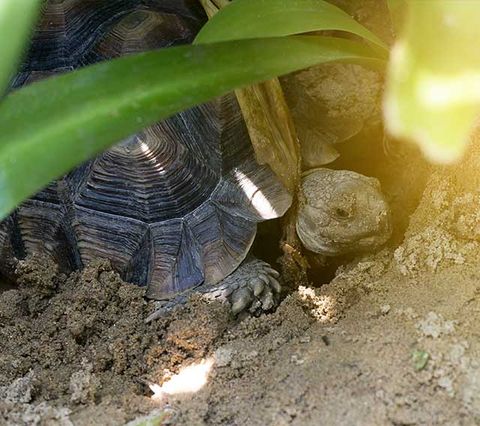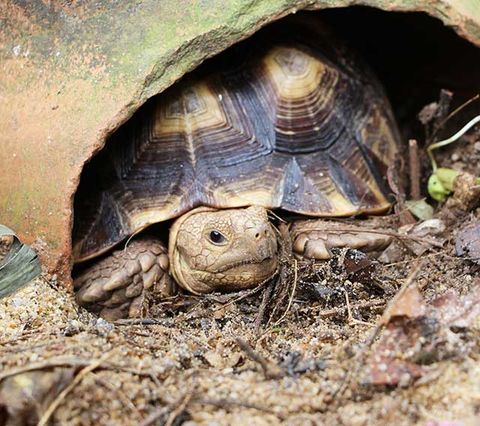Its recommended to keep hatchlings up to three years old or up to {100mm} plastron length awake during winter in a indoor heated enclosure.
Older tortoises can be hibernated safely, providing they are of good weight and are generally healthy and have shown no signs of respiratory problems. Remember that our summer months are much shorter and winters are much longer than southern Europe where they naturally live. To help extend the summer and reduce the time spent in hibernation its always best to use an indoor heated enclosure, from spring when they start to wake and in autumn, to prevent them from hibernating to early. Kept in a heated enclosure tortoises can be kept in a stable environment which will stimulate there appetite and prevent hibernation.
In the autumn, as early as the first week in September, night temperatures start to become cold and many tortoises stop eating, this is far to early for tortoises to start their hibernation. Again by using a heated indoor enclosure you can extend there summer to the end of October by maintaining a constant temperature and hours of day light. At the end of October you can start to reduce the hours of u.v light, plus day and night temperatures. Throughout this stage it’s important to carry on offering food. Reduce the day light from 14 hours per day to 12 hour in the first week, then down to 10 hours the following week and then down to 8 hours the week after that. So after three weeks the day light would have reduced from 14 hours down to 8.
Day and night temperatures should also be reduced over the same period of time from low 80’s down to low 60’s until the tortoise shows no signs of feeding due to its body temperature being to cool. During the period of cooling and reduced hours of light it’s important to bath your tortoises at least twice a week in warm water to help it pass as much as possible to empty its stomach before hibernation.
Continue reducing the temperature and light until they stop feeding. Start counting the days from when they last fed, after two weeks of not feeding at this stage the tortoise should have emptied its stomach contents and will be ready for hibernation. At this stage many tortoises will still show signs of activity and seem restless, this is normal.
Hibernation
Everything you need to know about tortoises hibernation
About hibernation
The most traumatic time for a tortoise owner is at the end of the summer when nights draw in, temperatures start to drop and the first thoughts of hibernation come to mind. Over many years, using different methods of hibernation, we have developed a relatively safe hibernation technique which, if followed correctly, should take most of the worry out of hibernation.
Preparing for hibernation
Although tortoises would normally hibernate in the wild from their first year as hatchlings it is not recommended for beginners to do so at such a delicate age.
Key to Success
The main issue of safe hibernation is to be able to maintain the tortoises body temperature between 3 and 7 degrees Celcius and not to allow it to fluctuate. This will keep the tortoises metabolism stable and prevent it burning off calories and losing body weight during hibernation.


Hibernation Technique
The following technique we have been using for many years and have found it to be the most natural and safe way to hibernate your tortoise.
Using a large, strong plastic box at least 30 cm deep and with a strong clip on ventilated lid, fill it half way with relatively dry garden compost or fine soil.
Even when it feels relatively dry to the touch it will naturally have some moisture content which will help prevent dehydration in hibernation.
Waking up in spring
Tortoises tend to start waking up around March when the weather becomes very mild and we start to get the first sunny days of spring. This is a perfect time to let your tortoise wake up naturally.
Important Notes to Remember
Indoor heated enclosures are one of the most important things to have when keeping tortoises as they can be used to extend the summer and reduce hibernation time.
Remember that you must make sure your tortoise has emptied its stomach before hibernating.
The hibernation box must be strong with a vented clip-on lid and stored between 3 - 7 degrees Celcius in a rodent-free place.
Make sure you use soil or compost which will prevent dehydration, temperature fluctuation and weight loss.
Don't forget to bath your tortoise every day when it wakes up in spring to re-hydrate it which will help it recover from the hibernation.
Always remember that tortoises are cold blooded creatures which depend on you to provide the right conditions for them to survive long-term, only put them outside then its dry warm weather, never leave them outside in damp wet and cold conditions.

